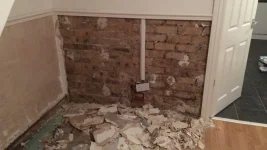You have reached the maximum number of views available on this site without registering.
You are using an out of date browser. It may not display this or other websites correctly.
You should upgrade or use an alternative browser.
You should upgrade or use an alternative browser.
Efflorescence on plaster
- Thread starter LHewitt4
- Start date
Monkey Boy
Well-Known Member
You have reached the maximum number of views available on this site without registering.
Last edited:
You have reached the maximum number of views available on this site without registering.
Tinytom
Well-Known Member
You have reached the maximum number of views available on this site without registering.
johniosaif
Well-Known Member
You have reached the maximum number of views available on this site without registering.
You have reached the maximum number of views available on this site without registering.
Attachments
You have reached the maximum number of views available on this site without registering.
ChrispyUK
Well-Known Member
You have reached the maximum number of views available on this site without registering.
You have reached the maximum number of views available on this site without registering.
ChrispyUK
Well-Known Member
You have reached the maximum number of views available on this site without registering.
You have reached the maximum number of views available on this site without registering.
ChrispyUK
Well-Known Member
You have reached the maximum number of views available on this site without registering.
Monkey Boy
Well-Known Member
You have reached the maximum number of views available on this site without registering.
You have reached the maximum number of views available on this site without registering.
Groove37
Well-Known Member
You have reached the maximum number of views available on this site without registering.
essexandy
The Lake Governor
You have reached the maximum number of views available on this site without registering.
paulf
Well-Known Member
You have reached the maximum number of views available on this site without registering.
ChrispyUK
Well-Known Member
You have reached the maximum number of views available on this site without registering.
ChrispyUK
Well-Known Member
You have reached the maximum number of views available on this site without registering.
ChrispyUK
Well-Known Member
You have reached the maximum number of views available on this site without registering.
Groove37
Well-Known Member
You have reached the maximum number of views available on this site without registering.
ChrispyUK
Well-Known Member
You have reached the maximum number of views available on this site without registering.
Groove37
Well-Known Member
You have reached the maximum number of views available on this site without registering.
paulf
Well-Known Member
You have reached the maximum number of views available on this site without registering.
ChrispyUK
Well-Known Member
You have reached the maximum number of views available on this site without registering.
Groove37
Well-Known Member
You have reached the maximum number of views available on this site without registering.
ChrispyUK
Well-Known Member
You have reached the maximum number of views available on this site without registering.
Monkey Boy
Well-Known Member
You have reached the maximum number of views available on this site without registering.
ChrispyUK
Well-Known Member
You have reached the maximum number of views available on this site without registering.
Stevieo
Royal Spin Doctor
You have reached the maximum number of views available on this site without registering.
Similar threads
- Replies
- 4
- Views
- 704
- Replies
- 2
- Views
- 101
- Replies
- 3
- Views
- 306
- Replies
- 10
- Views
- 1K


